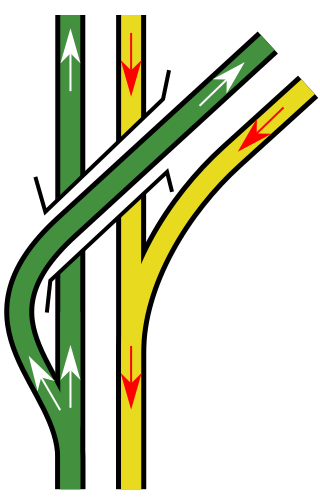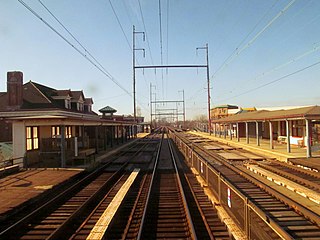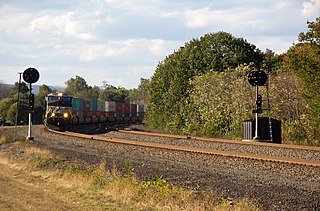
Zoo Junction is a junction on Amtrak's Northeast Corridor in Philadelphia, Pennsylvania where the Northeast Corridor meets the Keystone Corridor (ex-Pennsylvania Railroad main line). [1]

Zoo Junction is a junction on Amtrak's Northeast Corridor in Philadelphia, Pennsylvania where the Northeast Corridor meets the Keystone Corridor (ex-Pennsylvania Railroad main line). [1]


Zoo Interlocking track map | ||||||||||||||||||||||||||||||||||||||||||||||||||||||||||||||||||||||||||||||||||||||||||||||||||||||||||||||||||||||||||||||||||||||||||||||||||||||||||||||||||||||||||||||||||||||
|---|---|---|---|---|---|---|---|---|---|---|---|---|---|---|---|---|---|---|---|---|---|---|---|---|---|---|---|---|---|---|---|---|---|---|---|---|---|---|---|---|---|---|---|---|---|---|---|---|---|---|---|---|---|---|---|---|---|---|---|---|---|---|---|---|---|---|---|---|---|---|---|---|---|---|---|---|---|---|---|---|---|---|---|---|---|---|---|---|---|---|---|---|---|---|---|---|---|---|---|---|---|---|---|---|---|---|---|---|---|---|---|---|---|---|---|---|---|---|---|---|---|---|---|---|---|---|---|---|---|---|---|---|---|---|---|---|---|---|---|---|---|---|---|---|---|---|---|---|---|---|---|---|---|---|---|---|---|---|---|---|---|---|---|---|---|---|---|---|---|---|---|---|---|---|---|---|---|---|---|---|---|---|
| ||||||||||||||||||||||||||||||||||||||||||||||||||||||||||||||||||||||||||||||||||||||||||||||||||||||||||||||||||||||||||||||||||||||||||||||||||||||||||||||||||||||||||||||||||||||
| ||||||||||||||||||||||||||||||||||||||||||||||||||||||||||||||||||||||||||||||||||||||||||||||||||||||||||||||||||||||||||||||||||||||||||||||||||||||||||||||||||||||||||||||||||||||
Zoo Junction is a flying junction, where multiple tracks cross one another by bridges to avoid conflict with other trains. [1]
In 1870, the Pennsylvania Railroad built the Connecting Railway from Frankford Junction to Zoo to bypass congested street running in Philadelphia. [2] Instead of reaching the city directly from the north, the Connecting Railway turned west, crossed the Schuylkill River on the Connecting Railway Bridge (a stone arch viaduct) and then turned south to join the PRR's Main Line at Mantua Junction. Mantua was a wye junction controlled by three manual signal boxes; there was also an engine house and the massive 37th Street Yard in the center of the wye.
By 1888 the Mantua Junction was at capacity. In 1910 the PRR built two duck-under tunnels to allow trains to reach the Connecting Railway without blocking the Main Line and 37th Street Yard. The eastern 36th Street Tunnel also allowed grade-separated access to the Junction Railroad connecting to the Philadelphia and Reading Railway. Today, the tunnel only connects to the Northeast Corridor and is used by SEPTA, while the Junction Railroad now connects to the West Philadelphia Elevated as part of the CSX Harrisburg Subdivision. The western tunnel, called the New York-Pittsburgh Subway, allowed trains running from New York to Pittsburgh and west (such as the Broadway Limited) to bypass Broad Street station and a prolonged reverse move; such express trains would only stop in North Philadelphia. [3] In 1935, the interlocking reached its final form in conjunction with electrification and the construction of 30th Street Station and Suburban Station. Suburban commuter trains were routed to 30th Street's upper level towards Suburban, while intercity trains ran to the lower level.
In the crescent-shaped pocket between the junction and the river is the Philadelphia Zoo, which gave the interlocking its name. The former Zoological Garden station was located next to the interlocking to serve visitors to the Zoo.

The Northeast Corridor (NEC) is an electrified railroad line in the Northeast megalopolis of the United States. Owned primarily by Amtrak, it runs from Boston through Providence, New Haven, Bridgeport, Stamford, New York City, Trenton, Philadelphia, Wilmington and Baltimore to Washington, D.C. The NEC closely parallels Interstate 95 for most of its length, and is the busiest passenger rail line in the United States both by ridership and by service frequency as of 2013. The NEC carries more than 2,200 trains daily.

The Northeast Corridor Line is a commuter rail service operated by NJ Transit between the Trenton Transit Center and New York Penn Station on Amtrak's Northeast Corridor in the United States. The service is the successor to Pennsylvania Railroad commuter trains between Trenton and New York, and is NJ Transit's busiest commuter rail service. After arrival at New York Penn Station, some trains load passengers and return to New Jersey, while others continue east to Sunnyside Yard for storage. Most servicing is done at the Morrisville Yard, at the west end of the line. The Northeast Corridor Line is colored red on NJ Transit system maps and its symbol is the State House. The Princeton Branch is a shuttle service connecting to the line. Connecting SEPTA Trenton Line service between Philadelphia and Trenton is listed in the timetable.

The New York Connecting Railroad or NYCR is a rail line in the borough of Queens in New York City. It links New York City and Long Island by rail directly to the North American mainland. Amtrak, CSX, Canadian Pacific Railway, Providence and Worcester Railroad and New York and Atlantic Railway (NYAR) currently use the line. It runs from the Hell Gate Bridge over the East River to Fresh Pond Junction yard in Glendale in Queens. It was completed in 1917. Amtrak uses the northernmost section of the line from Sunnyside Junction in the Woodside section of Queens to the Hell Gate Bridge into the Bronx from which it follows the line north to Boston.
The Philadelphia and Trenton Railroad was a railroad from Philadelphia, Pennsylvania to Trenton, New Jersey. Opened in 1832, it became part of the Pennsylvania Railroad system in 1871. The majority of it is now part of Amtrak's Northeast Corridor.
The Junction Railroad was a railroad created in 1860 to connect lines west of downtown Philadelphia, Pennsylvania, and allow north-south traffic through the metropolitan area for the first time. The railroad consisted of 3.56 miles of double track and 5.3 miles of sidings. It owned no locomotives or rolling stock. The line connected the Philadelphia and Reading Rail Road line at the west end of the Columbia Bridge over the Schuylkill River, crossed the Pennsylvania Railroad line, ran parallel to Market Street, and turned south to connect with the Philadelphia, Wilmington and Baltimore Railroad at Gray's Ferry.

A flying junction or flyover is a railway junction at which one or more diverging or converging tracks in a multiple-track route cross other tracks on the route by bridge to avoid conflict with other train movements. A more technical term is "grade-separated junction". A burrowing junction or dive-under occurs where the diverging line passes below the main line.

The Chester Transportation Center is a SEPTA bus and train station in Chester, Pennsylvania. The outside portion of the ground level serves SEPTA City Transit Division Route 37, and Suburban Transit Division Routes 109, 113, 114, 117, 118, and 119.

The Baltimore and Potomac Railroad (B&P) operated from Baltimore, Maryland, southwest to Washington, D.C., from 1872 to 1902. Controlled by the Pennsylvania Railroad, it was the second railroad company to connect the nation's capital to the Northeastern States, and competed with the older Baltimore & Ohio Railroad.

The Keystone Corridor is a 349-mile (562 km) railroad corridor between Philadelphia and Pittsburgh, Pennsylvania, that consists of two rail lines: Amtrak and SEPTA's Philadelphia-to-Harrisburg main line, which hosts SEPTA's Paoli/Thorndale Line commuter rail service, and Amtrak's Keystone and Pennsylvanian inter-city trains; and the Norfolk Southern Pittsburgh Line. The corridor was originally the Main Line of the Pennsylvania Railroad.

Broad Street Station at Broad & Market streets was the primary passenger terminal for the Pennsylvania Railroad (PRR) in Philadelphia from early December 1881 to the 1950s. Located directly west of Philadelphia City Hall—15th Street went underneath the station—the site is now occupied by the northwest section of Dilworth Park and the office towers of Penn Center.
Railroad electrification in the United States began at the turn of the 20th century and comprised many different systems in many different geographical areas, few of which were connected. Despite this situation, these systems shared a small number of common reasons for electrification.

The Connecting Railway was a subsidiary of the Pennsylvania Railroad, incorporated to build a connection between the Philadelphia and Trenton Railroad and the PRR in the city of Philadelphia.

The Harrisburg Subdivision is a railroad line owned by CSX Transportation in the U.S. state of Pennsylvania. The line is located in the city of Philadelphia, connecting Greenwich Yard and the Philadelphia Subdivision with the Trenton Subdivision along a former Pennsylvania Railroad line. Much of the Harrisburg Subdivision is the High Line or West Philadelphia Elevated along 31st Street over the 30th Street Station area.

The West Philadelphia Elevated, also known as the High Line or Philadelphia High Line, is a railroad viaduct in the western part of Philadelphia, Pennsylvania. The 8,140-foot (2,480 m) structure spans the railway lines of 30th Street Station, parallel to the main track of the station, in a north-south direction. The 1,045-foot (319 m) approach made of brick arches is the longest brick bridge and probably the longest brick building in the United States.

North Philadelphia station is an intercity rail and regional rail station on the Northeast Corridor, located on North Broad Street in the North Philadelphia neighborhood of Philadelphia, Pennsylvania, United States. The Southeastern Pennsylvania Transportation Authority's (SEPTA) Regional Rail Trenton Line and Chestnut Hill West Line account for most of the station's service. Four Amtrak trains – three southbound and one northbound – stop on weekdays only.
The Shellpot Branch is a former Pennsylvania Railroad/Penn Central through-freight railroad owned and operated by Norfolk Southern since its acquisition, along with CSX Transportation, of Conrail in 1999. The branch allows Norfolk Southern, since the opening of a new bridge in 2001, to bypass the city of Wilmington, Delaware and allows direct access to both the Port of Wilmington and the New Castle Secondary, which connects to the Delmarva Subdivision of the Delmarva Central Railroad that runs to Central Delaware, Maryland, and Virginia's Eastern Shore. Both ends of the branch connect with Amtrak's Northeast Corridor and, like all of the PRR's through-freight lines, was electrified from 1935 until the Conrail era. The line was originally built doubly tracked, but was subsequently converted to single track.

Frankford Junction is a railroad junction, and former junction station, located on the border between the Harrowgate neighborhood of Philadelphia and Frankford, Philadelphia. At the junction, the 4-track Northeast Corridor line from Trenton connects with the 2-track Atlantic City Line from Atlantic City in the northeastern portion of Philadelphia about 2.9 miles (4.7 km) northeast of North Philadelphia station. It lies near the intersection of Frankford Avenue and Butler Street, to the west of the interchange between Interstate 95 and the approach to the Betsy Ross Bridge. It has been used for rail transportation since 1832 but has not served as a station since October 4, 1992.

Amtrak's 25 Hz traction power system is a traction power grid operated by Amtrak along the southern portion of its Northeast Corridor (NEC): the 226.6 route miles (362 km) between Washington, D.C. and New York City and the 104 route miles (167 km) between Philadelphia and Harrisburg, Pennsylvania. The Pennsylvania Railroad constructed it between 1915 and 1938. Amtrak inherited the system from Penn Central, the successor to the Pennsylvania Railroad, in 1976, along with the Northeast Corridor. This is the reason for using 25 Hz, as opposed to 60 Hz, which is the standard for power transmission in North America. In addition to serving the NEC, the system provides power to NJ Transit Rail Operations (NJT), the Southeastern Pennsylvania Transportation Authority (SEPTA) and the Maryland Area Regional Commuter Train (MARC). Only about half of the system's electrical capacity is used by Amtrak. The remainder is sold to the commuter railroads who operate their trains along the corridor.

Pennsylvania Railroad, Connecting Railway Bridge is a stone arch bridge in Philadelphia, Pennsylvania, that carries Amtrak Northeast Corridor rail lines and SEPTA and NJT commuter rail lines over the Schuylkill River. It is located in Fairmount Park, just upstream from the Girard Avenue Bridge.

The Pittsburgh Line is the Norfolk Southern Railway's primary east–west artery in its Pittsburgh Division and Harrisburg Division across the U.S. state of Pennsylvania and is part of the Keystone Corridor, Amtrak-Norfolk Southern's combined rail corridor.